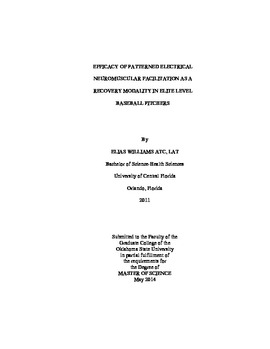| dc.contributor.advisor | Volberding, Jennifer | |
| dc.contributor.author | Williams, Elias | |
| dc.date.accessioned | 2015-06-17T20:08:37Z | |
| dc.date.available | 2015-06-17T20:08:37Z | |
| dc.date.issued | 2014-05-01 | |
| dc.identifier.uri | https://hdl.handle.net/11244/15189 | |
| dc.description.abstract | Introduction: The purpose of this study was to investigate the efficacy of patterned neuromuscular electrical stimulation (PENS), a specific type of electrical stimulation, as a recovery modality for collegiate pitchers. PENS was compared to active recovery (AR) and a cryotherapy control group (C). Methods: 16 healthy, college pitchers participated in this study. Each followed their normal throwing program prescribed by their pitching coach. Prior to a bullpen, each pitcher underwent the subjective and strength assessments (Pre). The parameters evaluated included two subjective measurements: perceived soreness (PS) and perceived percent readiness (PPR); as well as three strength assessments: shoulder abduction (abd-), shoulder external rotation (ER), and shoulder abduction while internally rotated (abd-/IR). Upon completion of the bullpen, participants received one of the three recovery modalities. At 24 hours (24P) and 48 hours post throwing (48P), subjective assessments were repeated, with an assessment of strength taken at 24 hours post throwing. Each pitcher went through this process three times, until each recovery modality had been performed once. Statistical Analysis: One way analysis of variance and paired samples t-tests were performed to evaluate the efficacy of each of the three modalities across time, across different measures, and against each other. Tukey's HSD were performed for all significant ANOVAs. Results: Significant differences were observed with the subjective measures across time. PS increased from Pre to 24P and decreased to near baseline levels from 24P to 48P with the C and AR interventions. Perceived soreness decreased from Pre to 24P and again from 24P to 48P with PENS. Perceived readiness followed a similar trend, decreasing from Pre to 24P and increasing to near baseline levels at 48P with C and AR, while PENS returned to better than baseline levels at 48P. Strength assessments never achieved significance. | |
| dc.format | application/pdf | |
| dc.language | en_US | |
| dc.publisher | Oklahoma State University | |
| dc.rights | Copyright is held by the author who has granted the Oklahoma State University Library the non-exclusive right to share this material in its institutional repository. Contact Digital Library Services at lib-dls@okstate.edu or 405-744-9161 for the permission policy on the use, reproduction or distribution of this material. | |
| dc.title | Efficacy of Patterned Electrical Neuromuscular Facilitation as a Recovery Modality in Elite Level Baseball Pitchers | |
| dc.type | text | |
| dc.contributor.committeeMember | Warren, Aric | |
| dc.contributor.committeeMember | O'Brien, Matthew | |
| osu.filename | Williams_okstate_0664M_13295.pdf | |
| osu.accesstype | Open Access | |
| dc.description.department | Education (all programs) | |
| dc.type.genre | Thesis | |
| dc.subject.keywords | baseball | |
| dc.subject.keywords | electrical | |
| dc.subject.keywords | patterned | |
| dc.subject.keywords | pens | |
| dc.subject.keywords | pitchers | |
| dc.subject.keywords | recovery | |
